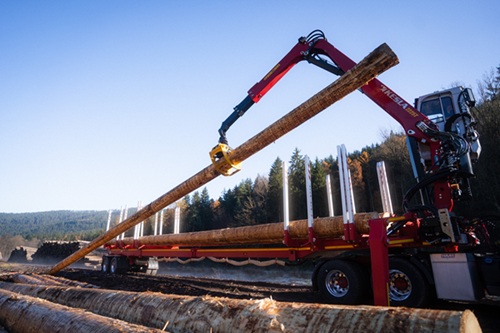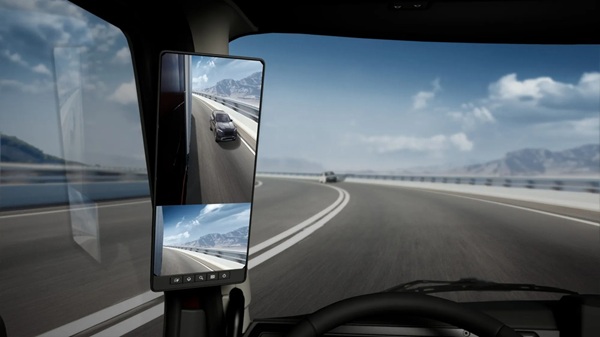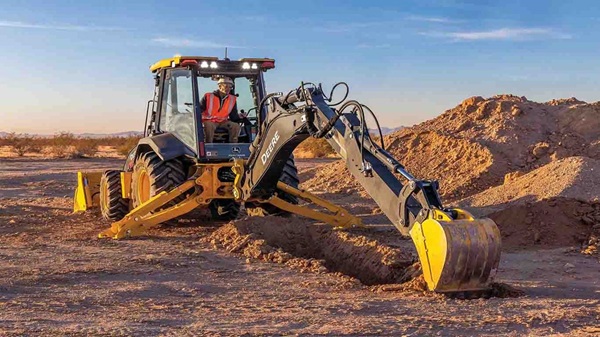
The 2225 and 2228 are designed for loading long timber.
Replacing the previous 2124L and 2024–2028 series, the Kesla 2225 and 2228 are engineered for demanding timber loading operations on semi-trailers and articulated trucks. With optimized hydraulics, robust boom structures, and advanced control systems, these cranes are built to meet the evolving needs of modern forestry.
The Kesla 2225 is ideal for semi-trailers, offering extra capacity with controlled speed. The Kesla 2228 has larger cylinders for increased lifting performance. Standard equipment includes Parker K130 valves with a 2-circuit system, while Parker L90LS valves are available as an option.
These cranes are purpose-built for whole-tree harvesting sites and cut-to-length log loading, with outreach options of 8.4 m (27.6 ft), 8.8 m (28.9 ft), 9.8 m (32.2 ft), and 10.2 m (33.5 ft). Optional log heels on the main boom enhance handling of long timber and poles.
The FD3850 flapdown stabilizer legs provide good stability on steep slopes and mountain roads, while the three stabilizer beam variants offer flexibility for different mounting configurations. The hydraulics are internally routed. Large-diameter hydraulic lines ensure fast, efficient movements with reduced thermal load. The proC i system allows proportional joystick control and optional electric damping.
The boom system is constructed from Strenx® 700 steel. The booms are both lightweight and durable. A dual-layer powder coating ensures long-lasting aesthetics and corrosion resistance. Bolt-on gland designs simplify maintenance of the cylinder, while the extension system features a fast-tightening 1” 4x6 chain and easy hose replacement. The boom can be stowed over the truck cabin, achieving a compact transport height of just 785 mm (30.9 in).
The redesigned high-seat offers superior comfort with adjustable suspension, a high backrest, armrests, seat heating, and safety features including an OPS switch and seat belt. Slide rails and an adjustable backrest ensure optimal ergonomics for long shifts. Source

Komatsu Forest aims to reduce the net carbon emissions from its forestry equipment.
In 2023, Komatsu Forest announced an initiative to establish a brand-new development department focused on the electrification of forestry machines. The initiative aligns fully with the company’s goals, where sustainability is a core principle throughout the entire operation.
Komatsu Forest have a carbon-neutral production facility and are working with the same determination to reduce CO2 emissions from the use of their forestry machines. The goal is to develop efficient products that are fundamentally designed to minimize environmental impact and reduce CO2 emissions, with electrification playing a key role.
Opening the door to electrification in forestry is a groundbreaking technological step for Komatsu Forest—but it also presents major challenges. Since the machines operate off-grid, outside the existing power network, many factors must be considered when developing new machine solutions. To enable the use of various energy sources, different energy distribution solutions are needed at the forest worksite. Success in this transition will require collaboration, partnerships, and the development of new technologies and system solutions.
Komatsu Forest have now developed a concept prototype. The concept prototype is a forwarder with hybrid-electric technology. Hybridization is a first step in electrification, where the existing renewable HVO100 fuel distribution can be used just like in conventional machines. The machine features a smaller but efficient engine connected to a generator. It is equipped with a battery pack that balances the engine load and improves the coordination of the machine’s functions. Many of the machine’s subsystems are fully electric, making it energy-efficient.
The goal of the machine is to reduce fuel consumption and CO2 emissions without compromising productivity, while also achieving improved performance and drivability. The concept prototype will now undergo testing and evaluation before the next step can be taken. Source

Logset 4F GT is the smallest forwarder in the Logset machine range.
The machine has a loading capacity of 10 tons, and it is especially designed for thinning operations in dense forests. Due to its small size, the Logset 4F GT literally floats on various types of terrain with minimum ground damage.
The Logset 4F GT, the last in the forwarder lineup to receive upgrades, now benefits from the 3.3 update package. In response to market demands, the bogie has been redesigned in a heavier-duty version, capable of supporting 24-inch wheels. Although the Logset 4F GT is a compact forwarder, it is powerful: the 4.9-litres AGCO Power engine develops 140 kW (190 hp). Available with the Mesera 83 crane with 106 kNm lifting capacity. The crane is available with two different length options for a customized reach.
Additional enhancements to the forwarder include:
- More than 10 cm (4 in) reduction in overall machine length for improved manoeuvrability.
- A more compact and ergonomic engine compartment.
- With its 140 kW (190 hp) engine, a strong Mesera crane offering 106 kNm of lifting force, and 140 kN tractive force, the 4F GT is a compact yet powerful forwarder in the 10-tonne load capacity class.
The cabin is efficiently insulated from noise and the surrounding large windows allow an excellent visibility on all tires as well as in all directions. With the user-friendly TOC 2 control system the operator can operate both crane and transmission with an incredible precision. The operator can work fast and efficiently without strain. The automatic cruise control allows the driving speed to be easily adjusted with a potentiometer.
The cabin offers good comfort and an unobstructed view when driving and loading. It is spacious and has various large storage compartments. The forwarder is easy to manoeuvre because the wheels are in sight all the time.
The forwarder is equipped with the user-friendly TOC 2 machine control system. Thanks to the control system, the operator saves a great deal of fuel, and the driving experience is soft and smooth. The crane controls can be adapted for each operator to ensure a fast and accurate control of the crane. Source

Mack Trucks announced comprehensive details of the industry-leading passive and active safety technologies.
The Pioneer introduces a suite of cutting-edge safety features, including front and side curtain airbags, an innovative digital mirror system and a high-strength steel cab designed to exceed rigorous safety standards.
To demonstrate Mack Trucks’ commitment to safety, the Pioneer comes standard with driver and passenger frontal airbags, with optional side curtain airbags. These supplemental restraint systems work in conjunction with carefully engineered seat belt systems and cab structures to provide maximum protection in the event of a collision.
The Pioneer also features Mack’s new E-Call 911, an advanced automatic emergency response system similar to those found in modern passenger vehicles, bringing automotive-grade safety technology to the commercial trucking industry. When activated by airbag deployment or a detected rollover event, the system automatically executes a series of coordinated safety measures: doors unlock to facilitate easy exit during emergencies, interior lights activate to improve visibility for first responders, and the system immediately contacts emergency services with the vehicle’s location. This comprehensive post-crash response protocol, long employed in the automotive industry, represents a significant advancement in commercial vehicle safety technology and promotes rapid emergency response when drivers need it most.
The Mack® Pioneer features a high-strength steel cab that exceeds federal safety requirements and additional rigorous global testing protocols. The cab has been tested against Swedish Impact (BOF10) standards and UN ECE R29 Cab Strength protocols. Additional tests, including frontal sled, trailer barrier and 90-degree rollover scenarios, also were conducted.
The Pioneer’s sophisticated chassis design includes splayed frame rails that direct crash energy away from the cab. The chassis frame itself is constructed using high-tensile steel that provides exceptional strength while maintaining optimal weight distribution for vehicle stability. In the event of a frontal collision, this design allows the engine to break away and drop below the cab rather than being pushed toward the driver.
A significant safety innovation in the Pioneer is the digital mirror system – a first for Mack – which replaces traditional side mirrors with cameras mounted in sleek pods. This system dramatically improves driver visibility by eliminating blind spots while simultaneously enhancing aerodynamics. Source

The upgrades include an industry-first rear camera system.
John Deere continues to refine its backhoe lineup with new machine and technology upgrades, enhancing operator comfort and jobsite awareness. The latest enhancements, an expanded, redesigned cab with five inches (12.7 cm) more of leg room when swivelling the seat and improved climate control to maximize operator efficiency and comfort.
The significant updates improve jobsite awareness, helping operators to navigate busy jobsites. With two side posts consolidated to one, this new cab provides an expanded field of view, particularly for truck loading and trenching operations. A new overhead rear window system offers an unobstructed view of trenches and tight spaces, increasing accuracy in underground applications.
An industry-first rear camera system, displayed on an 8-inch (20.3 cm) touchscreen, supplements operator vision and reduces rear structure obstructions, improving overall job site awareness. Additionally, upgraded LED work lights and LED turn signals enhance visibility in low-light conditions, enabling operators to work efficiently at any time of day.
John Deere prioritizes operator comfort with a redesigned cab that enhances the overall working experience. The cab is now five inches (12.7 cm) wider where the seat swivels, providing more space for manoeuvrability and seat transition, and helps keep operators comfortable during long hours of operation. An optional heated and vented seat, paired with an upgraded HVAC system that delivers 10% more airflow, ensures optimal climate control in all working conditions.
A redesigned palm-on-top loader grip helps support the operator's hand to keep operators comfortable through long working hours, while enhanced storage solutions offer better organization for tools and personal items. Together, these comfort-driven enhancements allow operators to work comfortably.
Additional updates include:
- Optional manual stabilizer locks and a stabilizer position warning system keep the operator informed of stabilizer position during transport. (Optional, all models)
- New pull-down front sunshade with more surface area to shield an operator from sun while in loader mode. (Optional, on P-Tier only)
- Redesigned pilot towers combined with the wider cab give operators more leg room for seat transitions. (Standard, all models)
- Common sealed switch module and centralized controls on all models provide keyless start, machine security and easy access to frequently used controls. (Standard, all models)
- Updated toolbox on outside of machine provides additional storage and includes new pressurized gas strut for ease of use and anti-corrosion hardware for longevity. (Optional on 310 G-Tier, standard on all P-Tier)
These new features, coupled with recent updates including Optional Heavy Lift and Pressure Compensated Load Sensing (PCLS) hydraulics on the 320, 410, and 710 P-Tier, make the newest John Deere backhoes a versatile machine on any jobsite. Source
MAN starts series production of electric trucks
A historic moment for MAN Truck & Bus as series production of MAN electric trucks has started. MAN CEO Alexander Vlaskamp and MAN Executive Board Member for Production & Logistics Michael Kobriger, together with Manfred Weber, Member of the European Parliament and Chairman of the EPP, gave the go-ahead at the Munich plant. From now on, both electric and diesel trucks will be produced in a fully integrated mixed production process on the same line. Source
Cat® Fleet Bucket Program enables customers to equip their buckets with Cat ground engaging tools regardless of brand
Caterpillar announces its Cat® Fleet Bucket Program, which allows customers to benefit from Cat ground engaging tools (GET) even on third-party buckets sourced from local bucket manufacturers. A new or rebuilt bucket, whether a Cat bucket or other brand, can now be equipped with Cat GET, available in multiple designs to meet the needs of specific applications, allowing customers and local bucket manufacturers to standardize on a single GET supplier. Source
Read More“Toward a digital twin of forest roads – road weather stations for monitoring road condition and trafficability in Eastern Finland.”
International Journal of Forest Engineering, 2025. Väätäinen, K., Kostensalo, J., Anttila, P., et al. Source
“Predicting the occurrence of root rot in tree stumps based on harvester data”
International Journal of Forest Engineering, 2025. Berg, S. Source
Read MoreTo see the full list of international logging, roading and trucking conferences and expo’s, please click the “Events” tab at the top of the page.
Read More